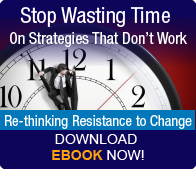Watch This Quick Video Recap:
If you are undergoing a business change, whether it is a minor procedural one or transformational in scope, chances are you are going to come across someone, somewhere in the organization who doesn’t like what’s going on. Truth be told, you’ll probably come across quite a few people who disagree with the change. Whether your resistance is out in the open, or lurking in a dark corner somewhere, trust us…it is there. 
Resistance to change isn’t logical and it can’t just be wished away. Resistance is very simply someone’s attempt to protect or defend his or her Frame of Reference. That’s why the level of resistance is directly linked to the impact of the change from the individual and/or collective’s point of view. Remember, disruptions will be different. What’s positive to one group of people, may cause a lot of uncertainty and stress for another. Don Harrison, developer of the AIM Change Management Methodology, puts it like this, “Resistance is actually quite predictable…the more disruptive a change is perceived to be, the greater the resistance you will face!”
5 Things to Know About Resistance to Change
Based on the principles of the AIM Change Management process, here are 5 things anyone involved in a strategic initiative needs to know about Resistance to Change
- The Type of Resistance You Confront Will Reflect Your Organizational Culture
Statements such as, “This is never going to work” or “We tried this years ago and it didn’t work” are examples of overt resistance. It doesn’t take a “rocket scientist” to figure out these are forms of resistance. But, resistance can also be subtle. And in a lot of cases, it will mirror your business culture. For example, if you have an analytical culture, your resistance will most likely sound analytical. "I'd like to support you, but I need proof this will work." Or, if your culture is risk averse, you'll hear statements like, "Well, I can get on board, but I need to know what everyone else thinks before I do that." No matter how it is expressed in your own organization, resistance needs to be surfaced as early as possible and then managed. - More Communication is Not the Answer
There is a common assumption that if you just tell people about the change, and tell them more often, you will eliminate resistance. But the truth of the matter is, you will never eliminate resistance by simply piling on logical and rational explanations for why the change will be good for people. So, if you are staying up nights trying to find the one perfect argument that will make everyone like your change, you should go back to sleep! To put it simply, you can’t communicate your way to eliminating resistance! - The Greatest Resistance is Usually in the Middle to Upper Levels of Organizations, Not at the "Front-lines" of the Change
One of the key principles we teach in our AIM Change Management Training is to expect the highest level of resistance from people who have the greatest motivation for things to remain the same. More often than not, this is your mid to upper level managers, because in the end, they are the ones who have the most to lose in terms of current and future power and prestige. This is more than just an interesting fact; it's highly problematic because these are the very people that you need as Sponsors. What can be done? It is critical to treat every level of the organization, from the senior leadership down, as Targets first. There is absolutely no point in trying to create readiness at the lower levels of the organization if the people in power are resisting the change. Instead, readiness needs to be cascaded through the organization level by level. - Resistance is Not All Bad
The good news is that resistance is not all bad. It’s a natural part of the change process and can actually be a sign of organizational health! A good Change Agent will take advantage of resistance and use it as project feedback. If it is purposefully managed, resistance can increase communication, promote genuine involvement, build resiliency and create opportunity for buy in to occur. - Resistance Cannot be Overcome, Eliminated or Solved
If resistance levels are, in fact, directly related to how disruptive the change is, it makes sense that the nature of the resistance and the amount of the resistance will vary as the disruption varies. This is why resistance management isn't as simple as just completing a checklist and it needs to be an ongoing activity. You will never combat, solve or overcome resistance to change. Here’s our best advice... take the time to surface resistance, understand its source and then manage it.
The impact of unmanaged resistance is clear -- implementation efforts are more likely to be over budget, behind schedule and not to expected specification. In other words, you don’t get the change you thought you needed. So, when it comes to resistance to change the question should not be whether you will or will not have it, but rather how much will there be and what strategies will you use to manage it.


